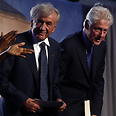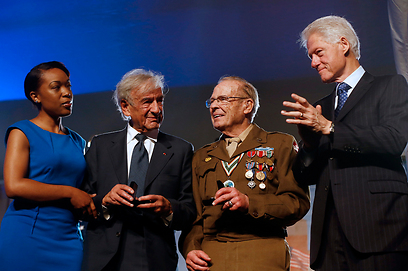
Holocaust survivors meet US liberators
In what could be their last big reunion, 1,000 Shoah survivors and World War II veterans join with former President Bill Clinton and Nobel Peace Prize laureate Elie Wiesel to mark US Holocaust Memorial Museum's 20th anniversary
One thousand survivors and World War II vets joined with former PresidentBill Clinton and Nobel Peace Prize laureate and Holocaust activist Elie Wiesel to mark the museum's 20th anniversary. Organizers chose not to wait for the 25th milestone because many survivors and vets may not be alive in another five or 10 years.
Video courtesy of jn1.tv
"We felt it was important, while that generation is still with us in fairly substantial numbers, to bring them together," said Museum Director Sara Bloomfield.
Washington has many monuments and memorials that offer something special for visitors from around the world, "but the Holocaust memorial will be our conscience," Clinton said.
Since the museum opened 20 years ago, the world has made huge scientific discoveries, including the sequencing of the human genome, which proved humans are 99.5% genetically the same, Clinton said.
"Every non age-related difference ... is contained in one half of 1% of our genetic makeup, but every one of us spends too much time on that half a percent," Clinton said. "That makes us vulnerable to the fever, the sickness that the Nazis gave to the Germans. That sickness is very alive across the world today."

Clinton (R) and poet Rebecca Dupas (L) present Wiesel (second from left) and World War II Army veteran Scottie Ooton, a member of 84th Infantry Division which liberated Hannover-Ahlem concentration camp, with pins marking 20th anniversary of US Holocaust Museum (Photo: AP)
The occasion marked a reunion of sorts for Clinton and Wiesel as well: Both were on hand to dedicate the museum at its opening in 1993. On Sunday night, the museum presented its highest honor to World War II veterans who helped end the Holocaust. Susan Eisenhower accepted the award on behalf of her grandfather, US Gen. Dwight D. Eisenhower, and all veterans of the era.
'In 10 more years, most of us will be gone'
Vera Greenwood, who was born in Berlin and remembers as a girl seeing Hitler with Nazis marching in the street, said her father knew they had to leave when he was forced out of his job as a lawyer. She remembers Nazi officers coming to their house and taking her father's books.
"Though I was very young, I knew something was very wrong," said Greenwood, now 84. "I still feel we were very lucky to survive."
Her family moved to Palestine with a British visa and ended up fighting for Israel's independence. Greenwood lived in Israel for 30 years before immigrating to the US and completing a doctorate at Arizona State University.
She and her husband, Fred, who survived the Holocaust in Holland as a child by being hidden and passed from house to house, wanted to be part of the last large reunion of survivors.
"In 10 more years, most of us will be gone," Greenwood said.
The museum continues collecting objects, photographs and other evidence of the Holocaust from survivors, veterans and archives located as far away as China and Argentina. Curators expect the collection to double in size over the next decade.
This week, the museum is opening a special, long-term exhibit titled "Some Were Neighbors: Collaboration and Complicity During the Holocaust." It includes interviews with perpetrators that have never been shown before, as well as details of mass killings in the former Soviet Union that were only uncovered in more recent years.
Curator Susan Bachrach said the exhibit and its research challenge the idea that the Holocaust was primarily about Hitler and other Nazi leaders. Surveys at the museum show that's what most visitors believe.
"That's very comforting to people, because it puts distance between the visitors and who was involved," Bachrach said.
So, the museum set out to look at ordinary people who looked on and were complicit in the killing and persecution of millions of Jews through greed, a desire for career advancement, peer pressure or other factors. It examines influences "beyond hatred and anti-Semitism," Bachrach said.
Focusing only on fanatical Nazis would be a serious misunderstanding of the Holocaust, Bloomfield added.
"The Holocaust wouldn't have been possible, first of all, without enormous indifference throughout Germany and German-occupied Europe, but also thousands of people who were, say, just doing their jobs," she said, such as a tax official who collected special taxes levied against Jews.
'Never Again: What You Do Matters'
In an opening film, some survivors recall being turned over to Nazi authorities in front of witnesses who did nothing. "The whole town was assembled ... looking at the Jews leaving," one survivor recalls.
Steven Fenves was a boy at the time. He recalled how in 1944, the government of Hungary, allied with Nazi Germany, forced his family out of its apartment. The family was deported to Auschwitz, where Fenves' mother was gassed.
"One of the nastiest memories I have is going on that journey and people were lined up, up the stairs, up to the door of the apartment, waiting to ransack whatever we left behind, cursing at us, yelling at us, spitting at us as we left," he said in an interview with the museum.
The museum located images of bystanders looking on as Jews were detained, humiliated and taken away.
Non-Jews were also punished for violating German policies against the mixing of ethnic groups. For the first time, the museum is showing striking, rare footage of a ritualistic shaming of a Polish girl and a German boy for having a relationship. They are marched through the streets of a town in Poland, where the film was located in an attic. Dozens of people look on as Nazi officers cut the hair of the two teenagers. They are forced to look at their nearly bald heads in a mirror before their hair is burned.
The federally funded museum's theme for its 20th anniversary is "Never Again: What You Do Matters." The museum devotes part of its work and research to preventing future genocides. A study released by the museum last month found that the longer the current conflict in Syria continues, the greater the danger that mass sectarian violence results in genocide.
Much more is still being learned about the Holocaust, as well, Bloomfield said. The museum is compiling an encyclopedia of all incarceration sites throughout Europe. When the project began, scholars expected to list 10,000 such sites. Now the number stands at 42,000.
Since opening, the museum has had more than 35 million visitors.










